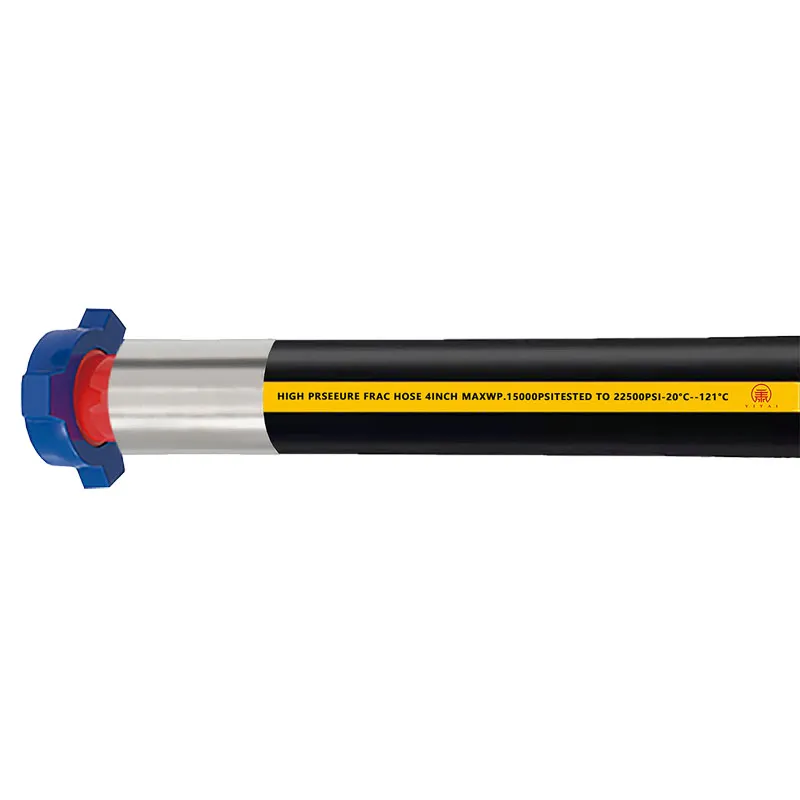How Temperature, Pressure, and Flexibility Impact Cementing Hose Selection for Optimal Performance
2024-11-15
In the challenging world of oil and gas drilling, selecting the right cementing hose is crucial for ensuring the success and safety of cementing operations. Cementing hoses are tasked with transporting cement slurry under high pressure to the wellbore, and they must be built to withstand demanding conditions. Temperature tolerance, pressure rating, and flexibility are the three primary factors that should be carefully considered when choosing a cementing hose.
In this blog, we will explore how each of these factors affects the selection process and why they are vital to achieving reliable performance in cementing applications.
1. Temperature Tolerance: Why Choosing the Right Temperature Range is Critical
Cementing operations are performed in a variety of temperature conditions, and cementing hoses must be designed to withstand these extremes to avoid premature failure.
- High-Temperature Applications: Cementing hoses need to be able to withstand the heat generated by the high-pressure pumping of cement slurry, as well as the natural heat from deep wellbore environments. Cement slurry is typically pumped at temperatures ranging from 150°F to 400°F (66°C to 204°C) in deep wells, and hoses that cannot handle these temperatures may degrade quickly, leading to leaks, bursts, or other operational failures. Choosing a hose with a high-temperature tolerance (e.g., hoses with heat-resistant rubber or synthetic materials) is essential for maintaining operational integrity.
- Low-Temperature Conditions: On the other hand, for operations in offshore environments or regions with colder climates, cementing hoses must also be able to endure extremely cold temperatures without becoming brittle or cracking. If the hose is too rigid in cold weather, it can be difficult to handle and may even fail under pressure. Selecting hoses with materials designed to remain flexible at low temperatures (such as thermoplastic or cold-resistant rubbers) is critical for ensuring safety in these environments.
Understanding the temperature conditions in which the cementing hose will be used is essential to choosing the right hose that won’t fail due to heat degradation or cold brittleness.
2. Pressure Rating: Ensuring Safety and Performance Under High Pressure
The pressure at which cementing hoses operate is a defining characteristic of their design. Cementing operations typically require hoses to withstand high pressures while transporting thick cement slurries.
- Pressure Resistance: The primary function of cementing hoses is to safely transfer cement slurry under pressure, sometimes exceeding 10,000 psi (pounds per square inch). Therefore, the pressure rating of the hose must be carefully matched to the expected working pressure. If the hose’s pressure rating is too low, the hose may burst or develop leaks, posing serious risks to personnel and equipment.
- Reinforced Layers: Hoses used for cementing must have a reinforced construction, often involving layers of steel wire braid or fabric to provide added strength. These reinforced layers allow the hose to maintain its integrity under pressure without bursting, elongating, or collapsing.
- Burst Pressure vs. Working Pressure: It’s essential to choose a hose with a working pressure that is well within its burst pressure limits. Burst pressure refers to the maximum pressure the hose can withstand before failing, while working pressure is the pressure at which the hose will safely operate under normal conditions. Manufacturers typically provide both values, and the working pressure should always be lower than the burst pressure to ensure safe operation.
Selecting the right hose with a sufficient pressure rating guarantees the integrity of the hose during cementing operations, helping to avoid dangerous failures.
3. Flexibility: Ensuring Maneuverability and Ease of Use in Tight Spaces
Flexibility plays a critical role in how easily cementing hoses can be handled, particularly in environments where space is limited and hoses must be routed around equipment or through tight openings.
- Bend Radius: The bend radius of a hose refers to the minimum curve it can make without kinking. A hose with too large a bend radius may be difficult to maneuver in cramped spaces, potentially leading to physical damage or operational inefficiencies. Selecting a hose with low bend radius ensures that it can be routed around equipment without restriction.
- Ease of Handling: Flexible hoses are easier to deploy, position, and retract during cementing operations. A hose that is too stiff can become a safety hazard, as it may not be able to reach the required destination or could snap under pressure if manipulated incorrectly. Choosing hoses with the right balance of flexibility and durability ensures both ease of use and long-term performance.
Selecting the right cementing hose is crucial for achieving optimal performance and safety during cementing operations. By considering temperature tolerance, pressure rating, and flexibility, operators can ensure that the hose will withstand the demanding conditions typical of cementing jobs. Whether you're working in high-temperature environments, managing extreme pressure, or navigating tight spaces, choosing the right cementing hose will help maximize efficiency and minimize the risk of failure. Always prioritize these key factors when making your selection to ensure reliable, long-lasting performance.



